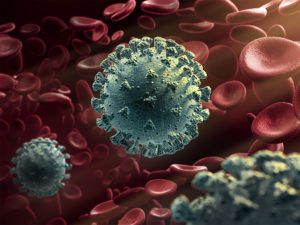OncoGen researchers propose personalized vaccinomics strategy for the novel China coronavirus

Image source: Eye of Science/SPL
Source: OncoGen News
Wuhan seafood market pneumonia virus, also known as 2019 Novel Coronavirus (2019-nCoV) is a relative of both the deadly severe acute respiratory syndrome (SARS) and the Middle East respiratory syndrome (MERS) viruses. According to Nature Briefing, by January 28, the number of confirmed cases has jumped to more than 4,500 with more than 100 people dead as a result of the infection. By comparison, SARS spread globally in 2002-03, infecting 8000 and killing more than 700 people.
Traditional vaccines for viral diseases had limited success in the case of viral epidemics with high mutation rates. The approach that we used for designing potential peptide vaccine candidates takes a more personalized strategy, referred to as vaccinomics, which enables the selection of target viral proteins with low mutation rates, and the design of peptides tuned to the immune characteristics of the target populations, variable based on geographic location and ethnicity.
Based on the human MHC (human leukocyte antigen) allele variation, the peptide vaccines can be made more relevant to a community or individual. The selection of the peptides that could act as vaccines is determined by the binding of the processed viral peptide with the major histocompatibility complex (MHC) class I and II molecules, and the relevant HLA alleles.
Our proposed candidate peptides take into consideration the most frequent HLA alleles found in the Romanian population.
Technical details of the approach used are detailed below:
We identified multiepitope peptide vaccine candidates against nCov that can potentially trigger both CD4+ and CD8+ T cell immune response. To this end, we designed 15-30 aa synthetic long peptides (SLPs), as proposed by Rabu et al. (2019), using a cathepsin-sensitive linker (LLSVGG) for linking MHC class I-restricted epitopes to MHC class II-restricted epitopes, with the MHC class II epitope located always at the N-terminal end, to stimulate both CTLs and T helper lymphocytes (together with innate immune system).
GenBank Acc. No. of coronavirus isolate Wuhan-Hu-1 used for analysis: MN908947.3 which is identical to Ref Seq NC_045512 (provisonal ref seq, under review by NCBI): https://www.ncbi.nlm.nih.gov/nuccore/NC_045512.2
It is an enveloped, positive-sense, single-stranded poly-adenylated RNA virus, with a genome of 29.9 kb (29903 bp), among the largest of all RNA virus genomes.
Complete genomic sequences known to date: S and M proteins important as target for nCoV vaccine; S = spike (for adhesion and fusion); M = membrane (for replication and virion exocytosis).
The tool from the Immune Epitope Database (IEDB) server was used to identify potent T cell epitopes from the sequences of S and M proteins. For CD8+ T cell epitopes, the prediction method integrated MHC class I binding, proteasomal cleavage and TAP transport efficiency. Several epitopes were selected for further analysis based on high overall score and if they showed high MHC binding affinity (IC50 <50 nM) (Table 1). For CD4+ T cell epitopes, the highest ranking peptide based on MHC class II binding was chosen (Table 2).
The class I and class II MHC alleles considered were the most frequent alleles in Romania, according to Constantinescu et al. (2017):
HLA-A*02 (29%)
HLA-A*01 (14.3%)
HLA-A*24 (11.2%)
HLA-B*35 (16%) (superfamily B07)
HLA-B*18 (11%) (superfamily B44)
HLA-DRB1*11 (18.5%)
HLA-DRB1*03 (11.3%)
HLA-DRB1*13 (10.5%)


Synthetic Long Peptide Vaccine candidate for S protein
GNYNYLYRLFRKSNLLSVGGYLQPRTFLL
YLQPRTFLL HLA-A*0201 epitope
GNYNYLYRLFRKSN HLA-DRB1*1101 epitope
LYRLFRKSNLLSVG HLA-DRB1*1301 epitope
Synthetic Long Peptide Vaccine candidate for M protein
SYFIASFRLFARTRSLLSVGGGLMWLSYFI
GLMWLSYFI HLA-A*0201 epitope
SYFIASFRLFARTRS HLA-DRB1*1101 epitope
ASFRLFARTRSLLS HLA-DRB1*1301 epitope
Synthetic Long Peptide Vaccine candidate for S and M proteins
SYFIASFRLFARTRSLLSVGGYLQPRTFLL
YLQPRTFLL HLA-A*0201 epitope
SYFIASFRLFARTRS HLA-DRB1*1101 epitope
ASFRLFARTRSLLS HLA-DRB1*1301 epitope
The candidate peptides presented above were designed by applying to viral antigens a technology used for personalized vaccination in cancer, based on long neoantigen peptides, currently in clinical trials for cancer therapy.
Based on this model, additional peptide candidates can be identified for populations from different geographic regions of the world.
The current approach is a compromise between an industrial large-scale global vaccination strategy and an individually-targeted personalized vaccination strategy.
We will continue the validation of these candidates and of the model.
Image source: Eye of Science/SPL



